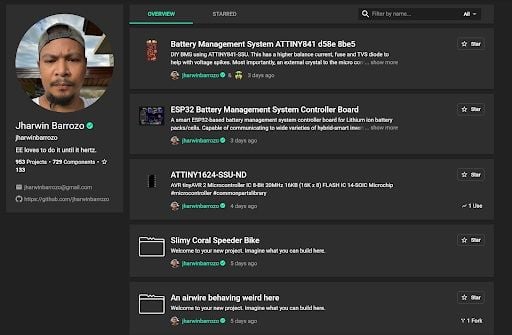Decades ago, engineers had few options if they wanted to share their work portfolio with colleagues or a potential employer. As a software engineer, you likely had to mail out CDs with your software for installation along with printed pages of the associated code. As a hardware engineer, you’d need to have a physical product in tow, along with drawings and schematics to explain the design.
6 Tips for Creating a Hardware Portfolio
- Use a browser-based PCB design tool to host your projects online.
- Use a free PCB design tool.
- Share your design on community websites.
- Contribute to open source projects.
- Create a website to share your designs.
- Enable hardware sharing.
Today, sharing your work portfolio has been made easier than ever. Software developers can simply upload their code to GitHub, host an app on Vercel and share URLs to their work for anyone in the world to see. But what about hardware developers?
Unlike software designs, hardware designs have remained persistently difficult and cumbersome to share with others. Here are some steps you can take to share your designs and boost your hardware portfolio.
Why Hardware Portfolios Matter
With the job market flooded with thousands of engineers who all have similar backgrounds, experiences and expertise, the work portfolio is key to standing out from the crowd.
Your unique flair for design, ability to problem solve and creative approach to engineering is hard to express fully in just a resume or a cover letter. A well-made portfolio can give you a leg up to show potential employers what you’re capable of.
Generally, a good portfolio is one that allows you to showcase your design experience with real project files and examples that a recruiter can look through. Unlike a resume, an engineering portfolio allows you to show them your skills, not just tell them.
A large contributor to the rise of the portfolio is the ease of access to information that the modern web has provided. Code repositories such as GitHub have enabled developers to upload their work and share it with anyone in the world with the ease of a URL. All a job seeker needs to do is link their GitHub page to their resume, and any potential employer can view that developer’s selected projects.
By doing this, developers can provide both recruiters and hiring managers with deeper insight into their working style and engineering ability. In this way, a work portfolio puts engineers at a huge advantage over their competing counterparts.
How to Build a Hardware Portfolio
Despite the huge advantages and popularity of work portfolios in other fields, true portfolios still seem to be all but nonexistent in the world of hardware engineering.
A major reason for this is the disaggregation of the hardware industry, where there seemingly exists no industry-standard design tool. Looking at the electrical engineering industry, there are a handful of popular and standard printed circuit board (PCB) design tools, but no one dominates them all. In fact, research shows that no one company holds more than 45 percent of the PCB design tool market.
The result is that a lack of a standard file format and software acts as a hindrance to sharing designs in a work portfolio, as designs from one tool may not be compatible with viewing in another tool. If an electrical engineer works in one tool but wants to share their work with an employer who works in another, complications ensue.
Beyond this, almost all major PCB design tools are run on locally hosted software that requires expensive licensing to access. Sharing designs in this scheme requires compressing design projects into ZIP files and sending them out either via email or some form of file-sharing service. Then, the recipient must have the design tool downloaded and paid for if they are to view the design on their end. This cumbersome and clumsy approach is a far cry away from the software industry where all that’s needed is a link to a GitHub page, from which anyone in the world can view a design right on their browser for free.
Because of these reasons, hardware portfolios have mostly been reduced to web pages full of pictures and descriptions of designs but lack access to the actual design files themselves. Where the goal is to show employers your technical skills, this is a huge missed opportunity for the entire hardware industry. Still, there are some ways hardware engineers can create a portfolio that stands out.
1. Use a Browser-Based PCB Design Tool to Host Your Projects Online
When you use a locally downloaded PCB design tool, your design files are inherently hard to access by anyone else. Instead, using a cloud-hosted, browser-based PCB design tool like Flux allows users to easily share their designs with anyone via a URL. This eliminates the clumsiness of sending full ZIP files back and forth.
2. Use a Free PCB Design Tool
To make sure that anybody is able to view your design projects without issue, it’s best to use a free PCB design tool. This way, anyone can access your design without getting stuck behind a paywall.
3. Share Your Design On Community Websites
Once you are using a browser-based PCB design tool, URL sharing opens up new worlds to you. For maximum visibility, share your projects on community sites like Reddit, Hackster, MakerPro or Hackaday, etc. As part of this, you could add a detailed written and/or video explanation of your work. This is an easy way to get more eyeballs on your design that would’ve been impossible without cloud-hosted tools.
Contribute to Open Source Projects
The best way to get visibility for your designs is to contribute to open-source projects. By contributing to projects that are viewed and used by other engineers, you can help create a name for yourself and make your work more visible.

Create a Website to Share Your Designs
By making your own portfolio website, you can consolidate all of your designs into one single place for people to see. Within this, the easiest way to share your designs is still via URL, but a website can act as an easy way to consolidate all of your work into one place. Tools like Flux also provide each user with their own user profile page, which hosts all of their projects and acts as a portfolio in itself.
Enabling Hardware Sharing
In today’s competitive engineering world, a design portfolio is a must-have for any job seeker. However, the hardware industry is plagued by a lack of design tool uniformity and accessibility, making it difficult if not impossible to put together a truly holistic portfolio. By using free and browser-based PCB design tools and contributing to open source projects, you can take major steps towards creating a large presence for yourself as a hardware designer.





